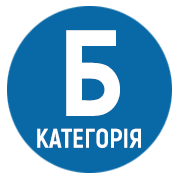FUTURE NATURAL SCIENCES TEACHERS TRAINING TO USE AUGMENTED REALITY TECHNOLOGIES IN PROFESSIONAL ACTIVITIES
DOI:
https://doi.org/10.32782/2415-3605.23.2.6Keywords:
education, students, quality, innovative technologies, educational applications, methodological system, criteriaAbstract
The essential characteristics of the most used technologies of augmented reality in the modern school of Ukraine have been outlined. Difficulties faced by practicing teachers and students in the context of the problem implementation have been determined by means of a questionnaire. The criteria, based on which it is expedient to outline a list of educational applications of augmented reality, with which it is advisable to familiarize future teachers (clarity of the interface, degree of popularization in Ukraine, technical accessibility, quality of the program content, compliance with the age characteristics of schoolchildren) have been singled out. A methodological system of the formation of future teachers’ abilities to use augmented reality technologies in the process of physics, chemistry, biology, and natural sciences studying has been proposed. It consists of two subsystems in which direct and indirect ways of skills formation are combined: subsystem I – to provide first level (bachelor’s) students with special goal-oriented relevant skills (direct way); subsystem II – practical application of acquired skills by the students at the second (master’s) level of higher education, who act as subjects of both educational and pedagogical activities (indirect way). A list of courses at which it is advisable to form relevant skills in various ways has been determined, namely (“Digital technologies in education and science”, “Digital technologies in professional activity”, “Innovative learning technologies”, “Theory and methodology of physics, chemistry, biology, natural sciences teaching”, etc.). Educational applications of augmented reality, which are expedient to use by natural sciences teachers in their professional activities have been characterized. The effectiveness of the proposed methodological system has been experimentally verified. Research has indicated that its implementation contributes to the improvement of the quality of future teachers’ readiness for educational activities in the conditions of the information society.
References
Візнюк В. Цифрова компетентність майбутніх педагогів як невід’ємна складова професійної підготовки. Наукові записки Тернопільського національного педагогічного університету імені Володимира Гнатюка. Серія «Педагогіка». 2019. Вип. 1. С. 130–136. DOI: https://doi.org/10.25128/2415-3605.19.1.17.
Волинець В.О. Віртуальна, доповнена і змішана реальність: сутність понять та специфіка відповідних комп’ютерних систем. Питання культурології. 2021. Вип. 37. С. 231–243. DOI: https://doi.org/10.31866/2410-1311.37.2021.237322.
Доповнена реальність: анонімне опитування вчителів природничих наук. URL: https://forms.gle/VwehtCUsYuxoYMWx6.
Доповнена реальність: анонімне опитування здобувачів вищої освіти. URL: https://forms.gle/A8zHwPsnKVLiAjDJ7.
Доповнена реальність як засіб реалізації дистанційного навчання в умовах карантину / В.В. Ткачук та ін. Освітній дискурс : збірник наукових праць. 2020. Т. 22. № 4. С. 43–53. DOI: https://doi.org/10.33930/ed.2019.5007.22(4)-4.
Степанюк А.В. Методологічні та теоретичні основи формування цілісності знань школярів про живу природу : дис. … докт. пед. наук : 13.00.01. Київ, 1999. 475 с.
Тарангул Л., Романюк С. Використання технології доповненої реальності в освітньому процесі закладів вищої освіти. Проблеми освіти. 2022. Т. 1. № 96. С. 187–204. DOI: https://doi.org/10.52256/2710-3986.1-96.2022.12.
Тимчина В., Тимчина Н. Нові перспективи освітнього процесу: віртуальна та доповнена реальність. New pedagogical thought. 2020. Т. 101. № 1. С. 42–46. DOI: https://doi.org/10.37026/2520-6427-2020-101-1-42-46.
Augmented reality: a class of displays on the reality-virtuality continuum / P. Milgram et al. Photonics for industrial applications / ed. by H. Das. Boston, MA, 1995. DOI: https://doi.org/10.1117/12.197321.
Azuma R.T. A survey of augmented reality. Presence: teleoperators and virtual environments. 1997. Vol. 6. No. 4. P. 355–385. DOI: https://doi.org/10.1162/pres.1997.6.4.355.
Current status, opportunities and challenges of augmented reality in education / H.-K. Wu et al. Computers & education. 2013. Vol. 62. P. 41–49. DOI: https://doi.org/10.1016/j.compedu.2012.10.024.
Klopfer E., Sheldon J. Augmenting your own reality: student authoring of science-based augmented reality games. New directions for youth development. 2010. Vol. 2010. No. 128. P. 85–94. DOI: https://doi.org/10.1002/yd.378.
Lytridis C., Tsinakos A. Evaluation of the ARTutor augmented reality educational platform in tertiary education. Smart learning environments. 2018. Vol. 5. No. 1. DOI: https://doi.org/10.1186/s40561-018-0058-x.
Methods of future science teachers training to use smart-technologies in the professional activity / A.V. Stepanyuk et al. South Florida Journal of development. 2022. Vol. 3. No. 1. P. 510–527. DOI: https://doi.org/10.46932/sfjdv3n1-038.
Mobile augmented reality: the potential for education / D. Nincarean et al. Procedia – social and behavioral sciences. 2013. Vol. 103. P. 657–664. DOI: https://doi.org/10.1016/j.sbspro.2013.10.385.
Phon D.N.E., Ali M.B., Halim N.D.A. Collaborative augmented reality in education: a review. 2014 International conference on teaching and learning in computing and engineering (LaTiCE), Kuching, Malaysia, 11–13 April 2014. Kuching, 2014. DOI: https://doi.org/10.1109/latice.2014.23.






